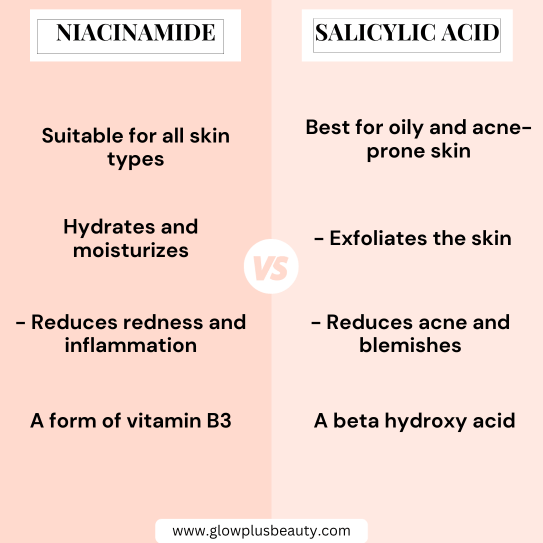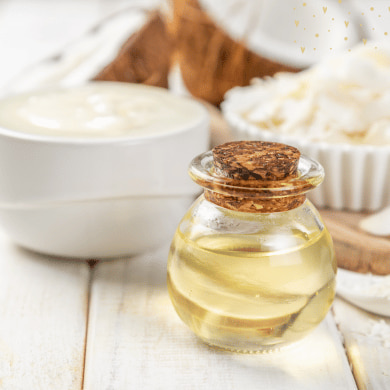Niacinamide Vs Salicylic Acid

Salicylic acid and niacinamide offer various skin benefits and are increasingly popular in skincare products. Salicylic acid helps smooth and clarify the skin, while niacinamide is known for its skin-healing properties. Combining these two ingredients can work well together in your skincare routine, providing a balanced approach to address multiple skin concerns effectively.
But what’s the real deal behind these skincare superheroes, and how do they fare against each other? Can you use niacinamide and salicylic acid together? Let’s break it down:
Let’s delve into the individual strengths of each ingredient, how to use them, how to combine salicylic acid and niacinamide effectively, and why these two should be essential components of your skincare regimen.
Related: Can You Use Salicylic Acid with Retinol Together?
But First off Understanding Niacinamide:
What Exactly Is Niacinamide?

Niacinamide – The Skin Soother
Niacinamide, also known as Vitamin B3 or Nicotinamide is a water-soluble vitamin with a proven track record in skin care. It is an essential component of the body’s natural lipid barrier and plays a crucial role in maintaining healthy skin.
7 Benefits of Niacinamide
Whether you have sensitive, dry, or oily skin, niacinamide can work wonders. It helps in reducing redness, fine lines, and pigmentation. Niacinamide can even help control the production of sebum, making it a fantastic choice for acne-prone skin.
It Improves Skin Barrier Function:
Niacinamide helps enhance the skin’s natural barrier, which is crucial for retaining moisture and protecting against environmental stressors. A strong barrier leads to softer, smoother skin.
It Balances Oil Production:
For those with oily or combination skin, niacinamide can help control excess oil production without over-drying the skin.
It is an anti-inflammatory:
Niacinamide has anti-inflammatory properties, which can soothe redness, calm irritated skin, and alleviate conditions like rosacea and acne.
It Fades Hyperpigmentation:
It inhibits the transfer of melanin within the skin, which can reduce the appearance of sunspots, age spots, and post-inflammatory hyperpigmentation.
It Brightens Skin Tone:
Niacinamide can visibly improve the evenness of your skin tone by reducing the appearance of dark spots, hyperpigmentation, and melasma.
It Fights With Acne:
Niacinamide can regulate sebum production and reduce inflammation, making it a helpful addition to acne management routines.
It Hydrates and Moisturizes skin:
It boosts the production of ceramides, which are essential for maintaining skin hydration. Niacinamide helps to keep your skin plump and moisturized, reducing dryness and flakiness.
Who Should Use Niacinamide?
As we know, Niacinamide is a versatile skincare ingredient suitable for a wide range of individuals with various skin types and concerns, including sensitive, acne-prone, aging, dry, oily, and combination skin.
Niacinamide is particularly effective for addressing issues like uneven skin tone, hyperpigmentation, fine lines, redness, and enlarged pores.
Its gentle nature and compatibility with other skincare products make it a popular choice for many.
However, as with any skincare ingredient, a patch test is advisable, especially for those with sensitive skin.
How To Incorporate Niacinamide
Niacinamide is a common ingredient you can find in various skincare products, such as serums, moisturizers, and toners.
Adding it to your routine is as simple as applying a few drops of a niacinamide serum before your moisturizer.
It’s a versatile ingredient that plays well with others in your skincare arsenal.
What Exactly Is Salicylic Acid?
Salicylic Acid – The Exfoliating Hero

Salicylic acid, categorized as beta hydroxy acid (BHA), is a naturally occurring compound extracted from willow bark and wintergreen leaves. It’s a common ingredient in numerous skincare products.
Salicylic acid serves as both an exfoliating agent and an effective treatment for acne. It helps get rid of old, dead skin by breaking the bonds holding it, so new, healthy skin can show up.
Being an oil-soluble acid makes salicylic acid special. It can really get into your pores and do a deep cleaning job, making it perfect for people with oily skin.
7 Benefits Of Salicylic Acid:
But salicylic acid isn’t just great for fighting pimples and blackheads; And guess what? It has more superpowers too!
It’s Acne-Prone Skin Savior:
Salicylic acid is well-known for its ability to effectively combat acne. It penetrates oil-clogged pores and exfoliates dead skin cells, preventing breakouts.
It’s particularly useful for those with oily or combination skin as it can help reduce excess oil production.
Works As An Exfoliation Expert:

As a beta-hydroxy acid (BHA), salicylic acid gently exfoliates the skin, promoting cell turnover. This results in a brighter complexion, reduced fine lines, and an even skin tone.
Unlike some other exfoliants, it’s well-suited for sensitive skin, as it’s milder and less likely to cause irritation.
Blackhead and Whitehead Eliminator:
Salicylic acid’s exfoliating properties also make it effective at clearing blackheads and whiteheads by dissolving the plugs that clog your pores.
It Has Antibacterial Properties:
Salicylic acid boasts an inherently acidic pH level, Salicylic acid’s natural acidity helps stop bacteria and germs from thriving. This means it can keep acne infections at bay. Goodbye to acne troubles!
It Minimizes Enlarged Pores:
Salicylic acid helps minimize pores by unclogging them. It gets rid of the gunk and dead skin cells that can make pores look bigger. So, with salicylic acid, your pores can appear smaller and cleaner.
It Evens Skin Tone:
Salicylic Acid can fade hyperpigmentation, promoting an even skin tone. This is particularly beneficial for those dealing with post-inflammatory hyperpigmentation or sun damage. It also evens out dark spots, thanks to its keratolytic properties.
It Fights Signs of Aging:
Salicylic acid helps your skin make more collagen naturally, which fights signs of aging like wrinkles and lines.
Who Should Use Salicylic Acid?
Salicylic acid is a versatile ingredient suitable for a wide range of skin types.
However, research has shown that its most significant benefits are observed in individuals with oily or acne-prone skin.
For those with naturally dry skin or a tendency toward dryness, using salicylic acid can be a bit challenging, as it is a chemical exfoliant, which may potentially exacerbate dry skin conditions.
However, if you have dry skin and still want to incorporate salicylic acid into your routine, the key is to opt for a gentler formulation that is specifically designed to minimize the risk of over-drying or irritation.
In addition, it’s crucial to team it up with a rich, hydrating moisturizer to maintain skin’s moisture balance and prevent any potential dryness or discomfort, ensuring your skin benefits from the exfoliating and pore-clearing properties of salicylic acid without any undue harshness.
Quick Tip:
It’s important to use a moisturizer with salicylic acid to keep your skin balanced and prevent dryness, so you can enjoy the benefits of exfoliation without any harsh effects.
What’s The Difference Between Niacinamide And Salicylic Acid?
Niacinamide Vs Salicylic Acid:

Salicylic Acid vs. Niacinamide: Which One is Better?
There isn’t a definitive “better” when it comes to salicylic acid and niacinamide; it’s about choosing what’s best for your specific skin needs.
For example,
If you have dry skin and are looking for a mild and effective option, a niacinamide serum might be the perfect choice. On the other hand, if you have oily skin, a product containing salicylic acid could be your best option.
Also, you can use salicylic acid as a spot treatment for acne and niacinamide as an overall serum to improve skin texture and tone.
It’s important to understand that one isn’t inherently superior to the other; each serves its purpose effectively.
In addition, there is also a benefit to incorporating both salicylic acid and niacinamide together into your skincare regimen.
How To Use Salicylic Acid And Niacinamide Together?
You can try using these two things at different times. In the morning, put on niacinamide to keep your skin hydrated all day.
For the salicylic acid, use it at night, and wait for thirty minutes before using your night creams and lotions.
Quick Tip:
Always follow up with good sunscreen in the morning.
FAQs About Niacinamide Vs Salicylic Acid:
Can I Use Salicylic Acid And Niacinamide Together?
Certainly, when it comes to using salicylic acid and niacinamide together, the answer is yes. These two ingredients actually work quite harmoniously in a skincare routine.
Salicylic acid, being oil-soluble, has the ability to penetrate the skin’s layers effectively, though it can sometimes lead to dehydration and irritation.
On the flip side, niacinamide plays a complementary role by enhancing the skin’s natural moisture levels and reducing inflammation.
In summarize,
Using salicylic acid by itself can effectively decrease breakouts, but it won’t provide the skin-strengthening and hydration-retaining benefits that niacinamide offers.
Conversely, relying solely on niacinamide can help smooth the skin, combat breakouts, and maintain moisture levels.
When you incorporate both salicylic acid and niacinamide, you will get the maximum benefits offered by both of them.
Can I Mix Salicylic Acid and Niacinamide Together?
We’ve confirmed that it’s okay to use salicylic acid and niacinamide together. Now, the question is, should you apply them one after the other or use products that already contain both?
For the best results, it’s advisable not to apply them at the same time because of their different pH levels.
Salicylic acid is typically formulated with a pH range of 3.0 to 4.0 to ensure effective skin penetration.
On the other hand, niacinamide has a neutral pH of around 6.0. When you mix salicylic acid and niacinamide, the acid’s pH goes up, making it less acidic. As a result, it can’t get into your skin as effectively, which can reduce its effectiveness.
Is Niacinamide Or Salicylic Acid Good For Acne Scars?
Niacinamide helps fade acne scars by reducing hyperpigmentation and discoloration.
It can help reduce redness and inflammation associated with acne scars and promote overall skin health.
Is Salicylic Acid Better Than Niacinamide For Oily Skin?
In contrast, salicylic acid is excellent for preventing new acne breakouts but doesn’t have a significant impact on lightening existing scars.
For those dealing with oily, acne-prone skin, both Salicylic Acid and Niacinamide serve as excellent options. They work well to control excess oil production and keep the skin from generating too much oil.




[…] Niacinamide Vs Salicylic Acid – Which Is Better For Your Skin? […]